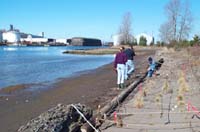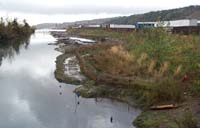|
Restoration of Commencement Bay, Tacoma, Washington
Commencement Bay is the harbor for Tacoma, Washington, located at the southern end of Puget Sound. Beginning in the early 1900s, intertidal areas and tideflats of the Puyallup River Delta were filled in and meandering streams were channelized, resulting in the eight waterways (Hylebos, Blair, Sitcum, Milwaukee, St. Paul, Middle, Thea Foss, and Wheeler-Osgood) that presently lead into the bay.
 |
|
Anchoring logs at the Middle Waterway Restoration Project, Tacoma, WA
|
Industrial and commercial activities are located on or adjacent to each of the waterways. They include pulp and lumber mills, shipbuilding and ship repair facilities, shipping docks, marinas, chlorine and chemical production facilities, concrete production facilities, aluminum smelting facilities, oil refineries, food processing plants, automotive repair shops, railroad operations, and numerous other storage, transportation, and chemical manufacturing companies. Contaminants originate from both point and nonpoint sources. In all, 763 drains (pipes), seeps, open channels, and other point and nonpoint discharges have been identified, although only a fraction of the 400-odd storm drains that empty into the bay have been associated with sediment contamination (Commencement Bay Nearshore/Tideflats Record of Decision, U.S. Environmental Protection Agency, 1989).
The nearshore area and waterways of Commencement Bay are used extensively as rearing and feeding habitat by numerous marine species, and the bay serves as a migratory pathway for salmonids. Three hatcheries annually stock approximately 4 million chinook, coho, and chum salmon and steelhead trout juveniles into the Puyallup River watershed. Many fish species feed on small epibenthic and benthic organisms before migrating offshore. NOAA's concerns about the Commencement Bay area involve the adverse effects to its trust resources caused by the release of hazardous substances in the bay and its waterways, and subsequent contamination of sediments on the bottom of the bay.
The U.S. Environmental Protection Agency's (EPA) record of decision for the Nearshore/Tideflats Superfund site treats each of the contaminated waterways as a distinct unit. EPA is addressing remedial action on a waterway-by-waterway basis, while the trustees are addressing damage assessment and restoration on a baywide basis. EPA has identified more than 150 potentially responsible parties (PRPs) for the Nearshore/Tideflats Superfund site.
In October 1991, the trustees formally initiated the damage assessment and restoration planning process by issuing a preassessment screen, a determination to perform assessment, and a notice of intent to perform assessment. Since that time, the trustees?occasionally in conjunction with several PRPs?have been compiling existing data, conducting studies of injuries to natural resources resulting from exposure to hazardous substances, entering into settlement agreements with willing parties, and planning and carrying out projects to restore injured resources and habitats.
 |
|
Mowitch Restoration Project, Tacoma, WA
|
The Commencement Bay natural resource trustees have developed a baywide restoration plan and are designing and building a series of habitat restoration projects using funds, property, and inkind services obtained through damage claim settlements. The trustees' restoration planning began with and was built upon the Commencement Bay Cumulative Impact Study (May/June 1993), which was developed by the U.S. Army Corps of Engineers, NOAA, the U.S. Fish and Wildlife Service, and the U.S. Environmental Protection Agency. That study analyzed the impact of dredge-and-fill activities on the bay's aquatic resources and identified restoration and mitigation options.
During Phase 1 of the natural resource damage assessment (NRDA) process, the trustees, potentially responsible parties, and local environmental organizations that make up the Commencement Bay NRDA Restoration Panel developed restoration goals and project evaluation criteria, and identified and evaluated a series of potential restoration sites. Building on the work of the restoration panel, the trustees prepared the baywide restoration plan and environmental impact statement to guide restoration project selection, design, and development. The restoration plan was formally adopted on October 3, 1997.
As the damage assessment has progressed, the trustees have entered into partial or full settlement of claims with several parties. These settlements have involved the creation of habitat restoration projects and the provision of funds, property, or services for projects to be planned and built in the future.
|


